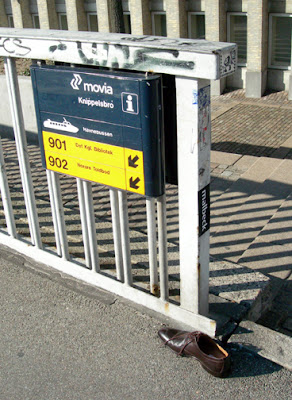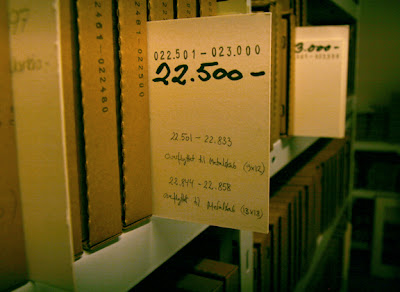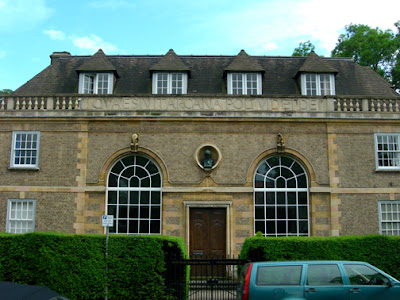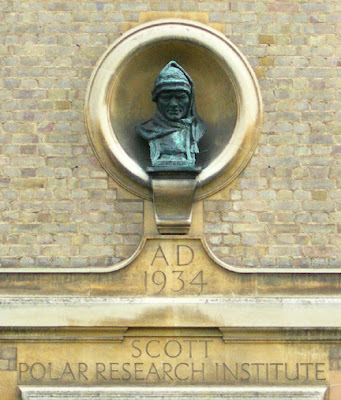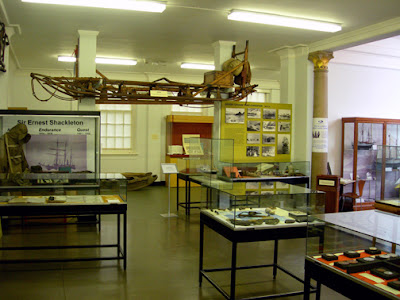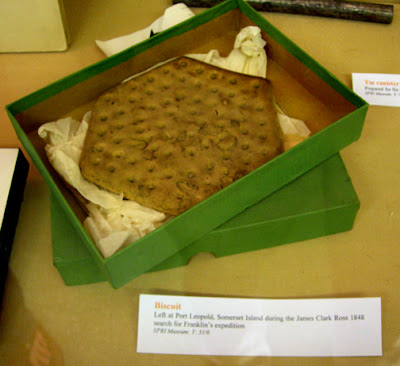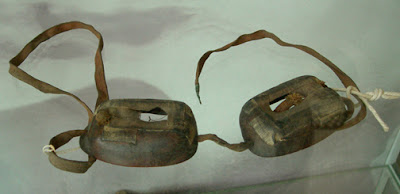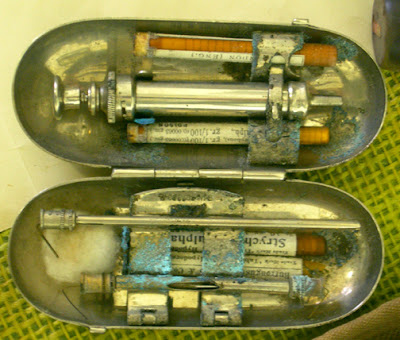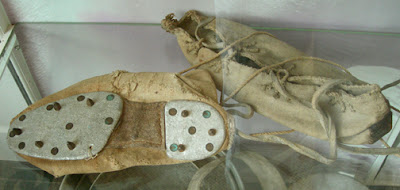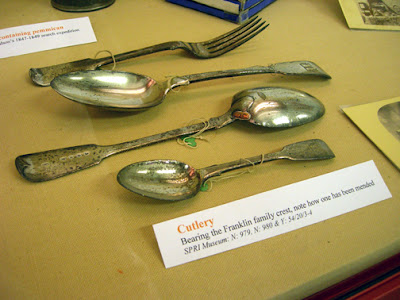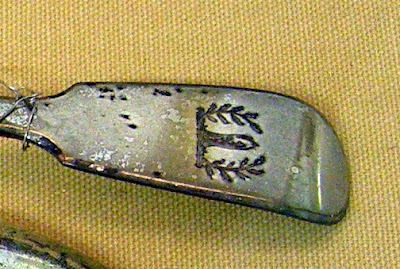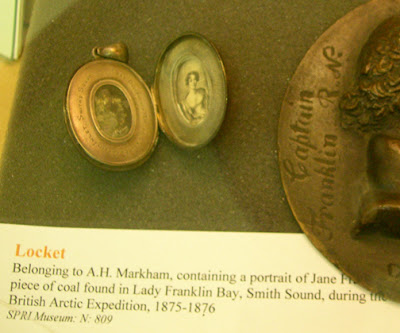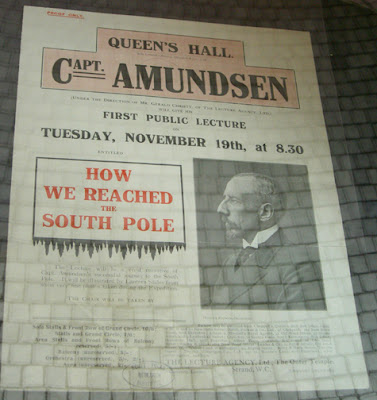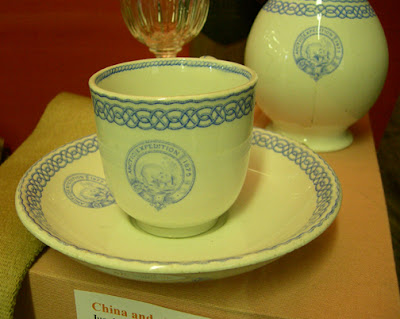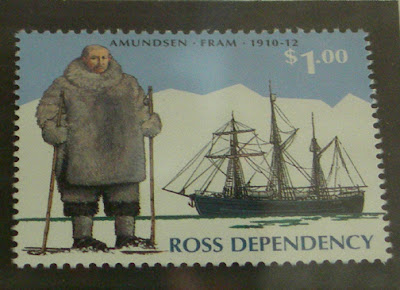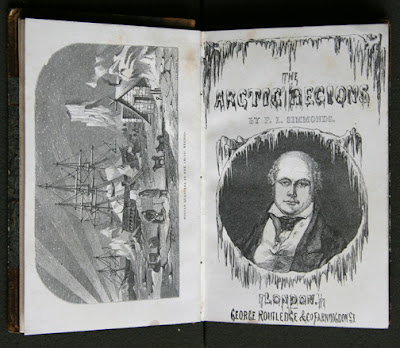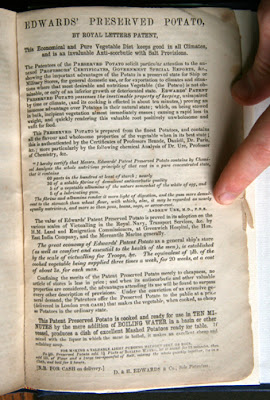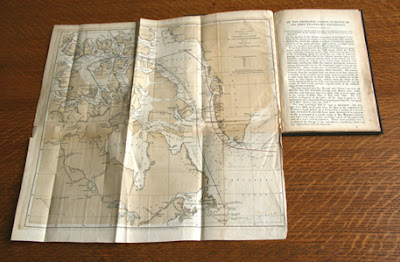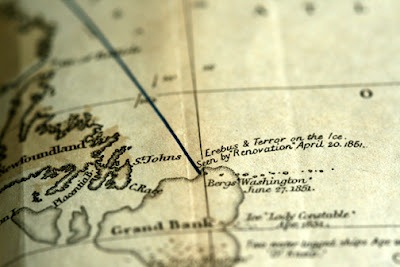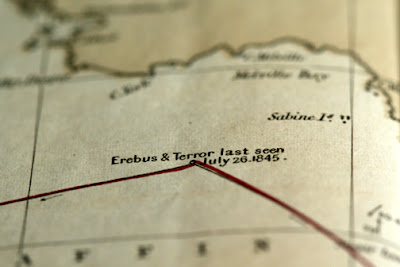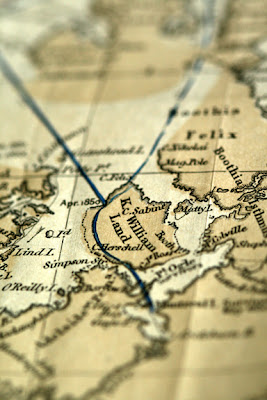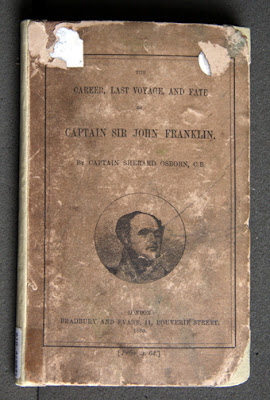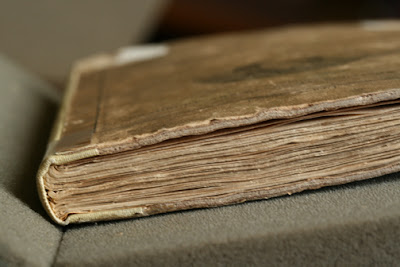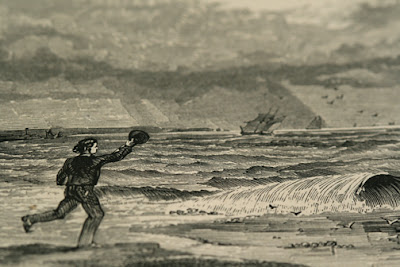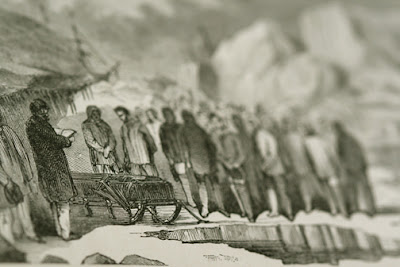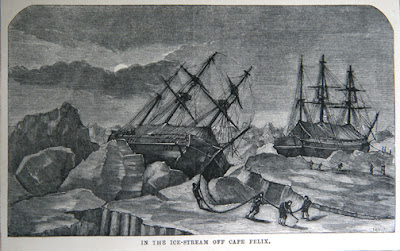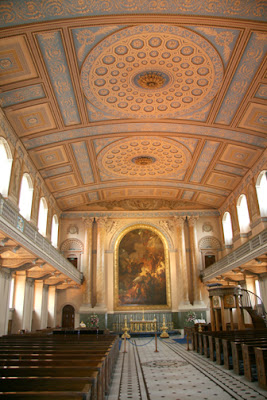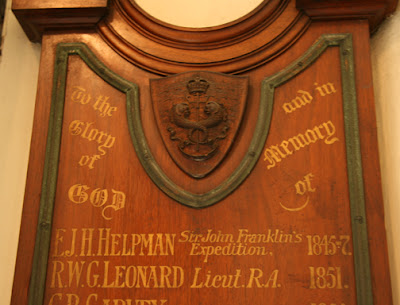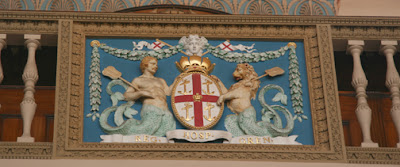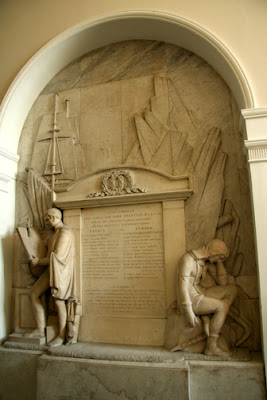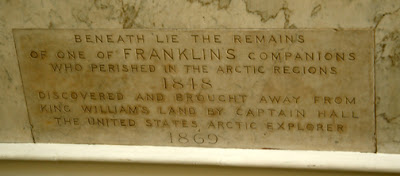
There is something about finding what you have been searching for: But not exactly what you have been searching for, rather, what has come to represent that which you have been searching for. A representation, an object, a thing that is not the actual thing, but the stand-in, the surrogate, the child that you weren't expecting to have or find. Your rune that allows you to catch your breath and stay frozen in the moment: a projection caught. You see the thing and you catch yourself becoming overwhelmed at the immensity of what you are seeing, staring, gaping at. It may have no significance to any other person, and perhaps once it didn't have significance for you either. But at that moment, at that instant, it has purpose, motive, and you partake in its energy.
For me, it was Captain Nares' sledge, which he used in 1876 during his arctic expedition. Rather, what his crewmembers used for it is not known which of his sledge parties used it as there were a few. This expedition had the most accounts of scurvy in all of 19th century polar exploration, even more than earlier expeditions. Coming upon this sledge was not with the intention of seeing specifically this sledge but rather seeing an example of a sledge. It just so happens that Captain M'Clintock designed this sledge during the 1850's for his expeditions: It represented the past-past, not just the past. It represented an evolution and multiple design changes that M'Clintock made. It probably represents a few other things, too, but that is not why I found significance in this object. I had a moment: these things are not easily understood or explained. Seeing this sledge across the expansive storage room, I almost cried. Amidst the sealed objects and ship bells, I gasped and had to catch my breath. And even now, I can't stop thinking about it. Did I really see it? I keep asking myself. I have the photographs to show that I stood in front of it and spent time with it, but I feel greedy. I wanted more time with it. I wanted to spend the day with it, the week with it. In fact, I want it in my house, to always see it. My photographs only magnify my miscomprehension, my muddled feelings towards the sledge.
Could it be defined as a religious experience? A spiritual experience? Perhaps. At least in my relationship to either of those two things, I would say that this sledge's energy is the closest thing I've felt to an 'awe' moment, which usually occurs during moments of personal divine reckoning, in a very very long time.
We find significance in text written by a person on a page, we build our own meaning of what they are saying, we carry this with us, perhaps memorizing it and making it a mantra that we pull out from time to time for lectures, dinner parties, romantic moments, discussions with children (or adults), and personal moments when we need that little bit of encouragement we once found in a book. These things that we construct for ourselves give back to us. They are like little wisps of nothing, perhaps a piece of shoe leather broken off a snow boot found in 1859 in the frozen arctic: it is a piece of trivial junk that manages to have power within its own insignificance. A passing comment, the low dense background rumble from the timpani during a symphony, or the piece of gum your grandmother always gave you at that symphony: your senses awaken and it all rushes back. You see that particular color and it floods you, pulling you under its currents to push you to the bottom of its ocean gorge. A deep well: from a sound, a color, a smell, a folded page, a photograph, a piece of long red hair found on your shirt one year later.

The weight of a sledge was perhaps 800 pounds once it was steeped with provisions that might have to last for thirty days out on the ice. Each man might have to pull twice his weight, every day, even on a bad day. British sledges weren't like Inuit sledges: they didn't ice their rails since they didn't know that this would make it easier. That was Amundson's role in the story of the Arctic. The British gained their knowledge about sledges from personal experience and from the Norwegians. Earlier on, they did not use dogs but instead 'man' power and then later kites and sails. They used dogs intermittently but not as much as they could have. They finally really learned how to drive sledges using dogs towards the end of the 1800's. The dogs were just more mouths to feed, so perhaps that is why they didn't use them at first? Or they were scared since that is what the 'natives' used? Or perhaps they didn't see the potential in them? Or perhaps they saw it as animal abuse? Though these were not what we now know as the American Huskie, these dogs were probably cross breed with wolves and traded from the Inuit. I am just speculating, I don’t know these things for certain and currently aren't too interested.
The problem with my photographs of the sledge and with the experience with being next to it, is that I felt rushed. One never wants to be rushed when they are having a divine experience. They want to feel relaxed and at ease in fully realizing every detail of the experience. Seeing the sledge, I felt rushed, timed, that I only had a few minutes to document and then move on. To know its personality and the type of each leather knot tied. Did I waste those few precious minutes, I ask myself now? Was there more for me to actually see? Was there more for me to realize about the 'event'? Did I miss something such as a smell or shaft of light marking a secret part of the sledge that I didn't see because I looked away for a moment, adjusting my lens or moving the metal ladder or…. I had the 'awe' moment, yes, but did I fully take advantage of the awe moment? I'm not sure. Are we ever able to fully capture every instance of such an occurrence or do we come to reconstruct them later in our mind, and evolve them into what we then say as 'Ah, yes, that was it, just like that. It occurred just as this and then that'? We process our language either out onto a page or for the aurality of another person. The 'awe' seeks a witness: Someone or thing to declare it as factual within our personal lives, as possessing a life of its own. And the event is formed. The restructured step by step processed to a fruition of meaning.
Walking home alone from dinner with friends, one of the red foxes of London crosses in front of me, hovers and then runs along. Pendrell Road, SE4 77W, 10:30 in the evening, walking back towards home, alone and missing you, Dundalk Rd and a house filled with guests, London in cold June: 'You never told me there were foxes in London', is formed into a poem, into meaning. It immediately possesses a voice of its own, singing to me. Capturing moments like on a cold January, it was so early morning blue outside when I came down to the kitchen at 6:30am, and going to the fridge, pulled out an orange: South African Midnight. Stunned at the sink to read a label such as this, on such a blue morning in my pajamas, alone in the kitchen, you upstairs asleep, and January's kiss on the trees.

These instances hold us together: They keep us, like water in our bodies, intact, in check, fluid in existence. Mundane activities of the hands keep us going at times: They let us continue when other things seem to want to prevent us from moving. There was a time when all I wanted to do was to use my hands in clay, without firing it. The thought of firing it froze me, scared me, to see something stop moving, so permanently, so fixed. I'm sure no one else in my art department had this fear, as they all seemed quite flexible in lending their time towards the lapping fires of the gas kilns that I deemed quite deathly in their ability to snuff out water. One could not turn back after a firing, as was evident of all the clay shards thrown into the rubbish out back behind the ceramic department: a graveyard formed every week before the garbage men came to pick up this funerary pile. I couldn’t get myself to partake in it. So I did my own thing and mixed clay with other materials viscous in nature that enabled them to slump and bend and be cut with an exacto knife, or left to crumble in their own delicacy. It seemed quite natural for me to leave them within the impermanence of the moment. And my undergraduate honors thesis reflected this shift in thoughts and the world: geological rock formations, birthmarks, personal anecdotes about 'home'.
And I still find myself within this realm of deceit: it is a tug-of-war game, really, that many don't seem to mind. It is not easy to move over constantly shifting ice floes or packs, where one has to repeatedly calculate their longitude and latitude, even when standing still. So close to the earth's axis of rotation is a remarkable thing. Activities are performed quicker, such as dressing in the morning, not because of the cold but just to catch up with the slowness of the equator. The sledges pulled would form part of that daily routine, as well as various scientific instruments that were packed onto the sledge, and, if you were so lucky, random Franklin crewmembers' personal objects that you found along your way, gems to be brought back to England, and perhaps something small for yourself. I wonder about the bones of John Irving, the only named crewmember to be buried on British terrain. Which sailor placed his bones into a box or were they wrapped in cloth? Holy relics, christened with polar ice and wind: those sensational bones, exulted on a sledge, a M'Clintock sledge, whose pallbearers still had to defy scurvy and weather on their way back to the ship, to defy their dwindling rations. Did the sailors hear the rattling of John's bones as they lay awake, hammocks in mid pendulum swing? Those protesting bones: because they were traveling in the opposite direction of the North West. Returning through the Baffin's Bay tunnel from whence those bones came with such optimism: Water all around them, but not enough to mold their flesh together again. Is he lonely, feeling at odds in his British cemetery, displaced?
There are many things at odds with themselves that lay within the confines of a museum's storage: ship models, anchors, pieces of gold trimmed railing, masts, silk handkerchiefs, shoes, clay pipes, sails, shreds of clothing. Like criminals they are trapped without visitors, in gang rooms. Their bunks lining walls and walls and their bedding of plastic sheet: Some, if they are lucky to be small, a tissue shroud. But more than a prison, a tomb.
That is where the sledge, my sledge, lay in state: its Westminster or Royal Naval Hall miles away. I'm sure it has had a few visitors, unlike some of its comrades, and has been written about, short epitaphs in conference papers or distinguished journals. Should we bury our objects just as we bury our bodies? Would our histories suddenly mean more, would we actually learn from our pasts instead of merely discussing them? Those conference paper, those published thesis? I'm not sure. I don't know how things would be different. Museums or garbage dumps: A person's private collection or a private moment within the confines of a storage facility. Searching through 'history' reveals many poignant potshards and scat. And a sledge can become the thing that the entire world rests on, instead of a turtle's back.

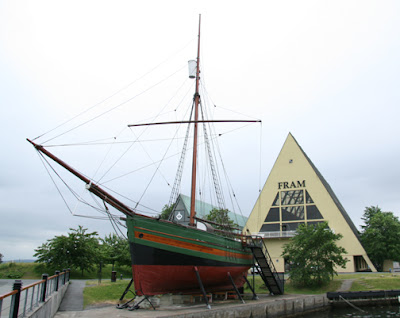 missing the sense of water, of a fjørd, a route, if needed, and the possibility that an ocean current could carry off my past. I carried my objects back with me in addition to a few I had traded for: a Norwegian blanket, native food such as chocolate and candy, two Danish designed spoons, a pair of London shoes, and some random items that one can collect on foreign lands. The maps that guided my travels also allowed for my return voyage accompanied with filled notesbooks of data and narrative imagery of first hand experiences.
missing the sense of water, of a fjørd, a route, if needed, and the possibility that an ocean current could carry off my past. I carried my objects back with me in addition to a few I had traded for: a Norwegian blanket, native food such as chocolate and candy, two Danish designed spoons, a pair of London shoes, and some random items that one can collect on foreign lands. The maps that guided my travels also allowed for my return voyage accompanied with filled notesbooks of data and narrative imagery of first hand experiences.
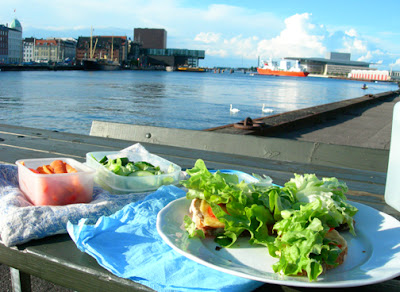
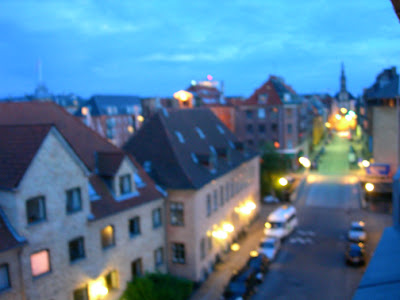
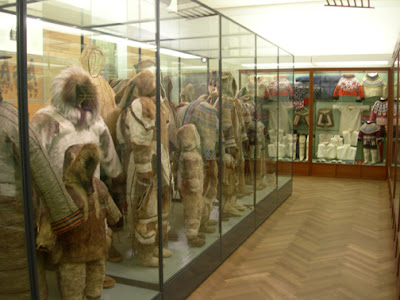
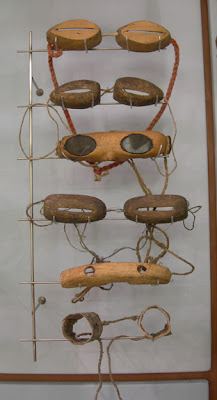 Goggles used in Greenland to aid hunters so that they can see in the blinding summer light reflections off the snow and ice.
Goggles used in Greenland to aid hunters so that they can see in the blinding summer light reflections off the snow and ice.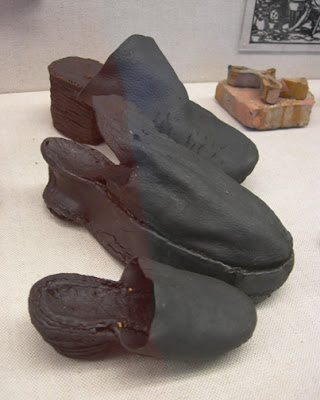 Shoes dug up in an old section of København a few years ago.
Shoes dug up in an old section of København a few years ago.